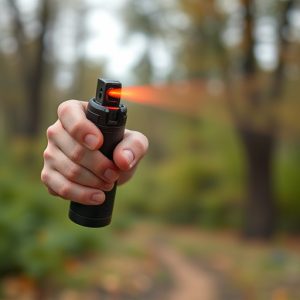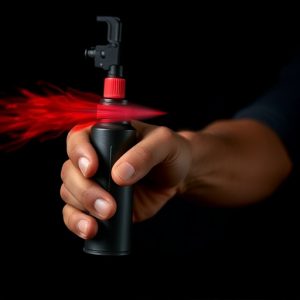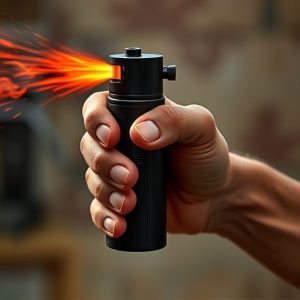Storing Pepper Spray: Maximizing Law Enforcement’s Riot Control Potential
Storing pepper spray properly is paramount for maintaining its effectiveness in law enforcement. The…….
Storing pepper spray properly is paramount for maintaining its effectiveness in law enforcement. The ideal storage conditions include cool, dry temperatures below 75°F (24°C), protection from direct sunlight, and secure locations to prevent unauthorized access. Adhering to these practices ensures officers have a potent tool during civil disturbances, while respecting legal standards that balance public safety with individual liberties through proper de-escalation techniques and regular training. Well-maintained equipment and comprehensive officer training are essential for optimal riot control using pepper spray.
Riot control agents are powerful tools used by law enforcement to manage crowd disorder, but their proper handling and storage are crucial for officer safety and community trust. This article delves into the world of riot control agents, focusing on pepper spray as a primary example. We’ll explore various aspects, including understanding agent types, safe storing practices to ensure maximum effectiveness, legal considerations, and essential training guidelines for officers. By following best practices, law enforcement agencies can maximize the impact of these tools while adhering to regulatory standards.
- Understanding Riot Control Agents: Types and Their Role in Law Enforcement
- Safe Storing Practices for Pepper Spray: Ensuring Optimal Performance
- Legal Considerations and Regulations Surrounding Riot Control Agent Use
- Best Practices for Officer Training and Equipment Maintenance
Understanding Riot Control Agents: Types and Their Role in Law Enforcement
Riot control agents, a diverse range of chemical substances, play a pivotal role in law enforcement strategies, particularly during civil disturbances or large-scale gatherings. These agents are designed to disrupt and disperse crowds while minimizing physical harm. The most common types include pepper spray, tear gas canisters, and smoke bombs, each with unique properties for specific tactical needs.
Effective use of these agents relies heavily on proper storage and handling. For instance, storing pepper spray in secure locations, maintaining its temperature, and ensuring it’s easily accessible during operations are vital for maximum effectiveness. Law enforcement agencies must adhere to strict protocols to guarantee the integrity and readiness of riot control gear, thereby facilitating swift and controlled responses during chaotic situations.
Safe Storing Practices for Pepper Spray: Ensuring Optimal Performance
Proper storing practices are essential for maintaining pepper spray’s optimal performance and effectiveness in law enforcement operations. Unlike some other riot control agents, pepper spray is sensitive to temperature and light fluctuations. It should be stored in a cool, dry place, away from direct sunlight and heat sources. Many manufacturers recommend keeping it at temperatures below 75°F (24°C) for maximum shelf life. In addition, store the spray in a secure location, as unauthorized access could compromise its integrity or render it useless when needed most.
To ensure pepper spray remains potent and ready for use, consider using original packaging or airtight containers. Avoid leaving the container open for extended periods, as exposure to air can reduce its effectiveness. Given that pepper spray is designed for quick deployment in high-pressure situations, reliable storage methods are key to ensuring officers have access to a powerful yet safe tool during riot control or other emergency scenarios.
Legal Considerations and Regulations Surrounding Riot Control Agent Use
The legal landscape surrounding riot control agents, such as pepper spray, is a complex web of federal and state regulations designed to balance public safety with individual rights. Law enforcement agencies must navigate these laws meticulously to ensure the responsible use and storage of these powerful tools. One critical aspect is adhering to guidelines for storing pepper spray to maintain its effectiveness; this involves securing the agents in cool, dry places, away from direct sunlight or extreme temperatures, to prevent degradation.
Regulations also dictate when and how riot control agents can be deployed. Law enforcement officials are trained to employ these tools as a last resort, only when non-lethal means have been exhausted, and when necessary to restore order and protect both officers and civilians. Proper usage and de-escalation techniques are paramount, with ongoing training sessions focusing on these skills to ensure compliance with legal standards and the preservation of civil liberties.
Best Practices for Officer Training and Equipment Maintenance
In the realm of riot control, effective law enforcement depends on well-trained officers and properly maintained equipment. One crucial aspect is the storage of pepper spray to ensure its maximum effectiveness. Officers should be trained to store the spray in a cool, dry place, away from direct sunlight or extreme temperatures. This helps maintain the chemical’s potency, ensuring it’s ready when needed. Regular maintenance includes checking expiration dates, inspecting for damage, and cleaning containers to prevent any contamination that could reduce its efficacy.
Furthermore, training should emphasize proper usage techniques. Officers need to learn how to deploy pepper spray safely and effectively during chaotic situations. This includes understanding wind patterns, targeting specific areas, and being aware of the spray’s range and duration. Continuous refresher courses can help maintain proficiency, ensuring officers are prepared to handle high-pressure scenarios with confidence and precision.
Riot control agents, especially pepper spray, are powerful tools in law enforcement, but their effectiveness hinges on proper storage practices and adherence to legal guidelines. By understanding the various types of agents, implementing safe storing methods like those outlined for optimal performance, and ensuring comprehensive officer training along with regular equipment maintenance, law enforcement agencies can maximize the impact of these substances while mitigating potential risks. These strategies are essential components of a well-rounded approach to public safety in managing civil disturbances.


